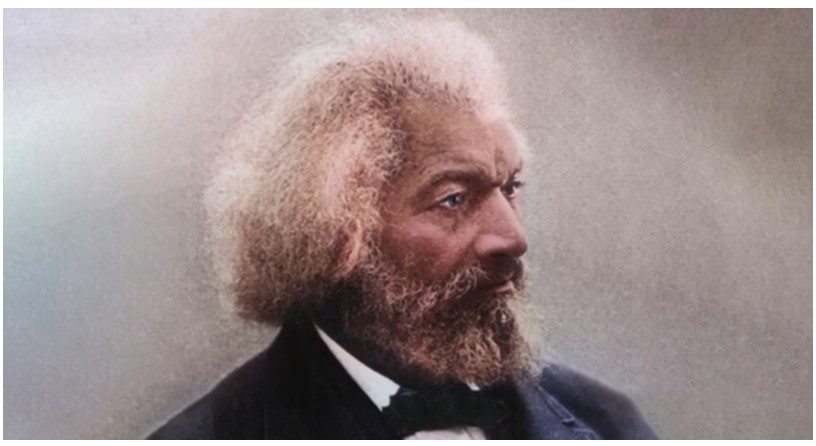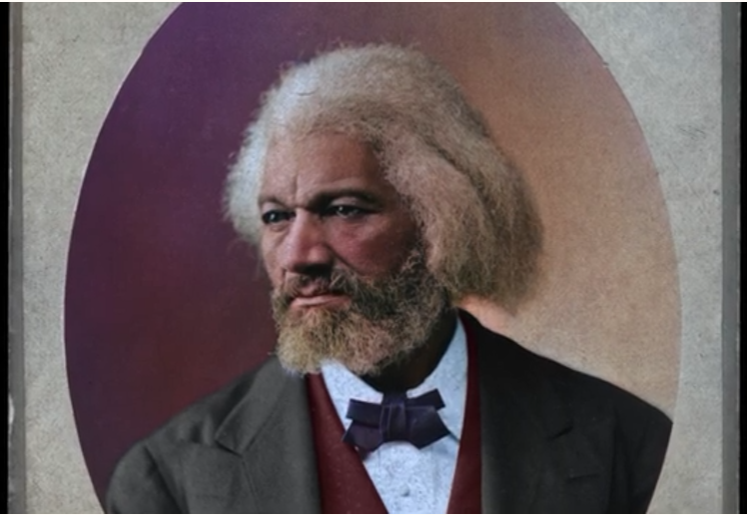 By Neenah Payne
By Neenah Payne
Frederick Douglass (1818–1895) has a special meaning for me because his family had the foresight in the 19th century to found Highland Beach near Annapolis, Maryland so Black Americans could have access to the beaches of the Chesapeake Bay when America was still segregated. Until I was 16, I spent every summer in the home my family had at Highland Beach. When I slept on the swing, I could hear the soothing sound of the bay as it rolled in and out. We went to the creek to catch Blue Claw crabs we pressure cooked and delighted in. A friend’s father took us water skiing. We played Canasta every night.
Because there were no street lights then, it was pitch black at night and we could see the Milky Way on full display. As a resident of New York City now, I deeply miss that magnificent night sky. The Douglass family had a home right down the road, near the “Post Office” which was in someone’s home. On Saturday nights, kids gathered at the Pavilion to watch Superman flicks.
My mother and I could go across the road to gather delicious blackberries. The “Ice Man” delivered the morning paper, ice, bread, milk, and eggs. The Good Humor man brought a range of treats. The Fourth of July was “Family Day” when the extended family visited and we had sparklers and other fireworks. Those summers were truly a magical time thanks to the vision of Frederick Douglass’ family.
Every summer, I put up this triptych because it is almost exactly the view of the pier from our porch!
A Brief History of Historic Highland Beach:
In 1892, Major Charles Douglass, youngest son of Frederick Douglass, and Charles’ wife Laura, were turned away from a restaurant at the Bay Ridge Resort and Amusement Park because of their race. The resort was separated by a narrow channel—the mouth of Black Walnut Creek—from property owned by the Brashears, a local black family. Crossing the channel, it was through a chance encounter between a member of the Brashears family and Charles and Laura Douglass that the origins of Highland Beach are rooted.
After discussions over the next several months, and with financial assistance from his father, Charles Douglass worked out an arrangement to purchase a two-thirds interest in forty acres of the original forty-eight-acre Brashears estate from two of the heirs—Daniel Brashears and Georgianna Lane. In the spring of 1893, they settled on the purchase of twenty-six and two-thirds acres of land that would become Highland Beach. And almost a century later, in 1988, Highland Beach annexed the eight-acre Dr. John E. Washington tract.
By 1894, Douglass had built the first cottage, establishing a retreat for himself and others on the Chesapeake Bay. With 600 feet of beachfront, he turned it into a summer enclave for family and friends. Frederick Douglass—famed activist for abolition and women’s suffrage, orator, publisher, diplomat and adviser to President Abraham Lincoln, perhaps the most famous black man of his time, and one of the most photographed personalities in our nation’s history—would have become a resident had he not died in 1895 before the summer home that his son Charles was building for him was completed.
The Town of Highland Beach became a gathering place for educated blacks, including many of the well-known blacks of the time and later years. Among the residents and guests were—Paul Robeson, concert artist and stage and film actor famous for his cultural accomplishments as well as for his political activism; Judge Robert Terrell, who served as one of the first municipal court judges in Washington, D.C., and his wife, Dr. Mary Church Terrell, one of the first African American women to earn a college degree, who became known nationally as an activist for civil rights and women’s suffrage; Booker T. Washington, author, educator, orator, and advisor to U.S. presidents; Robert Weaver, who served as the first African American appointed to a cabinet position in the federal government as the U.S. Secretary of Housing and Urban Development; W.E.B. Du Bois, sociologist, historian, civil rights activist, and author; Paul Laurence Dunbar, poet, novelist, and playwright; Langston Hughes, poet, social activist, novelist, and columnist; E. Franklin Frazier, sociologist and author of the books The Negro Family in the United States (1939), and Black Bourgeoisie (1957); and later, author Alex Haley, perhaps most famously known for his ground-breaking book Roots: The Saga of an American Family (1976), that became a national sensation as a television production.
When Highland Beach was incorporated in 1922, it became the first African American municipality in Maryland. It is also believed to be the first African American summer resort in the United States. Although founded as a summer resort, it is now a town of both summer and year-round residents who choose not to permit commercial establishments.
There are approximately 80 homes, many of them still owned and occupied by descendants of the original settlers. The residents are proud and protective of their town’s heritage, established by proud and successful people determined to overcome the prejudices of their post-Reconstruction times. Highland Beach is the home of Twin Oaks, which now serves as the Frederick Douglass Museum and Cultural Center, Inc.
Highland Beach is bordered on the north by Black Walnut Creek and the community of Bay Ridge, on the east by the Chesapeake Bay, and on the south by Oyster Creek and the community of Venice Beach. Our beachfront is for the benefit of Highland Beach and Venice Beach residents and their guests (provided they have a guest pass).
Douglass’ Historic Fourth of July Speech
Douglass escaped slavery and is known for his very powerful Fourth of July speech “What To The Slave Is The Fourth of July?” which he delivered in 1852 in Rochester, NY, his hometown. In the video below, some of his descendants deliver his historic speech.
A Nation’s Story: “What to the Slave is the Fourth of July?”
Historian David W. Blight says in the video below that the 25-page speech is now widely read in communities across America because, “People have found in it both the critique of America, but also a remarkable expression of the promise of America – of America’s creeds if they are lived up to. Douglass loved the Declaration of Independence. He loved the principles. He hated the practices before the Civil War.”
David W. Blight is a New York Historical Society trustee, Sterling Professor of History and Director of the Gilder Lehrman Center for the Study of Slavery, Resistance, and Abolition, Yale University, Pulitzer Prize winning author.
Blight describes two significant aspects of Douglass’ famous speech:
- It is a rhetorical masterpiece. It is a masterpiece of oratory in every element of technique you can imagine.
- It is an embittered and poignant and yet, in the end, uplighting criticism of American political hypocrisy as you will ever read. It was in 1852, two years after the Fugitive Slave Act.
Blight says that Douglass honors the Founding Fathers for their glorious idea. He points out that it is one of the greatest warnings about who we are, and who we can be, and who we once were. He points out that we too are still part of this story and asks “Do we live up to these creeds?”
“Born into slavery on the eastern shore of Maryland, Frederick Douglass was sent at age ten to labor for a family in Baltimore, where his slave master’s sympathetic wife taught him the rudiments of reading and writing. With no formal schooling, Douglass educated himself by reading everything he could get his hands on. (He took his last name from the hero of Sir Walter Scott’s epic poem The Lady of the Lake.)
In his late teens, he was hired out to a cruel master whom he defied in an act of great moral and physical courage. Disguised as a sailor, the twenty-year-old Douglass escaped to New York and began his extraordinary career as an abolitionist orator, writer, newspaper publisher, and governmental official.
Douglass published three autobiographical books. The first and most influential of these is Narrative of the Life of Frederick Douglass, an American Slave, Written by Himself (1845). The book focuses on the victims of slavery and the barbaric crimes inflicted upon them. It was an immediate success and today is considered a classic slave narrative.
A powerful physical presence and a superb orator, Douglass dramatically preached freedom and independence for slaves. His speech “What to the Slave is the Fourth of July?” may be the greatest statement ever of the moral and physical harm of slavery, while exposing the hypocrisy of white people for their founding ideals.
He was an early champion of women’s rights and printed the motto “Right Is Of No Sex—Truth Is Of No Color” on the masthead of his abolitionist newspaper The North Star. His vision was also international in scope; he advocated fair treatment for working people in England, Ireland, and Scotland. Yet, his most important work continued to be in the United States.
During the Civil War, Douglass wrote: “We are fighting for unity; unity of idea, unity of sentiment, unity of object, unity of institutions, in which there shall be no North, no South, no East, no West, no black, no white, but a solidarity of the nation, making every slave free, and every free man a voter.””
“One of the most prominent civil rights figures in history, Frederick Douglass escaped from slavery and spent his life advocating for social justice, holding a place within the ranks of such prominent figures as President Lincoln, William Lloyd Garrison, Harriet Tubman, and Susan B. Anthony. Douglass saw the fruits of his labor with the 13th Amendment, but was more than aware of the long struggle African-Americans would face in the years to come.
Born into slavery in Bay-side Talbot County, Maryland in 1818, Douglass, born Frederick Augustus Washington Bailey, was the son of Harriet Bailey and a white man. Separated from his mother as an infant, he lived with his maternal grandmother Betty Bailey until the age of seven.
At the age of twelve, Douglass was sent to Baltimore to serve the family of Hugh and Lucretia Auld, “a kind and tender-hearted woman.” It was Mrs. Auld who first taught him the alphabet, in spite of the fact that she was breaking the law by doing so. Douglass, aware of the power of a good education, secretly taught himself to read and write, resolving to one day escape to freedom.
In 1832, Douglass was sent out of the city to the plantation of Hugh’s brother, Thomas Auld. Thomas, in turn, sent Douglass to the notorious “negro-breaker and slave-driver” Edward Covey. Covey prided himself on his ability to crush any slave’s will to resist enslavement and beat Douglass savagely. One day when he was sixteen Douglass fought back and physically bested Covey, who never whipped him again.
On September 3, 1838, dressed in a sailor’s uniform and carrying papers provided by a free black seaman, Frederick Douglass escaped aboard a train bound for Havre de Grace, Maryland. From there, he continued to New York and eventually New Bedford, Massachusetts, where he settled. As he would remark to audiences years later: “I appear before you this evening as a thief and a robber. I stole this head, these limbs, this body from my master and ran off with them.” Douglass soon married Anna Murray, a free black woman he had met while enslaved in Baltimore, with whom he had five children: Charles, Rosetta, Lewis, Frederick Jr. and Annie, who died at the age of ten.
In 1841, while attending anti-slavery meetings, Douglass met William Lloyd Garrison, founder of The Liberator and one of the most outspoken abolitionists in the country. Garrison encouraged Douglass to share his story, catapulting his career. Douglass began giving lectures at abolitionist conventions, quickly earning a reputation as an eloquent and compelling speaker.
In 1845, Douglass, with the encouragement of Garrison and Wendell Phillips, another prominent abolitionist, published his celebrated Narrative of the Life of Frederick Douglass: An American Slave. The work was an instant success. Critics charged that it was so well-written that it could never have been composed by a black man. The narrative made Douglass a widely-known public figure, even beyond abolitionist circles, which led some of his allies to fear for his safety, lest his former owner Thomas Auld come looking for his now-famous ‘property.’ Accordingly, Douglass sailed for the United Kingdom later that year. Douglass remained abroad for two years, during which time a group of English admirers made arrangements to purchase his freedom.
During the turbulent decade of the 1850s, Douglass worked tirelessly for emancipation, breaking with William Lloyd Garrison over his approach (Garrison would publicly burn copies of the Constitution, which he regarded as a patently pro-slavery document) in order to publish his own newspaper, the North Star.
By the Civil War, Frederick Douglass was the most prominent black man in the United States. During the war, Douglass consistently petitioned President Lincoln to make emancipation an explicit war aim and to sanction the raising of colored regiments. Two of his sons served in the 54th Massachusetts regiment, the first to be comprised of African-American soldiers.
After seeing his life’s work vindicated with the passage of the 13th, 14th and 15th amendments to the Constitution, Douglass held various government posts and continued to labor through the period of Reconstruction and beyond to secure civil rights for freedmen, sagely remarking, “Verily, the work does not end with the abolition of slavery, but only begins.”
Douglass moved to Washington D.C. in 1877 and became the editor of the New National Era. His wife Anna died five years later. Douglass was remarried two years later to Helen Pitts, a white feminist and the daughter of an abolitionist colleague and friend, Gideon Pitts Jr. In 1888, he became the first African-American to receive a vote for President of the United States in a major party’s roll call at the Republican National Convention in Chicago. Frederick Douglass died February 20, 1895, and is buried in the Mount Hope Cemetery in Rochester.
Blight is the author of Frederick Douglass: Prophet of Freedom.
Amazon Description
**Winner of the Pulitzer Prize in History**
“Extraordinary…a great American biography” (The New Yorker) of the most important African-American of the nineteenth century: Frederick Douglass, the escaped slave who became the greatest orator of his day and one of the leading abolitionists and writers of the era.
As a young man, Frederick Douglass (1818–1895) escaped from slavery in Baltimore, Maryland. He was fortunate to have been taught to read by his slave owner mistress, and he would go on to become one of the major literary figures of his time. His very existence gave the lie to slave owners: with dignity and great intelligence he bore witness to the brutality of slavery.
Initially mentored by William Lloyd Garrison, Douglass spoke widely, using his own story to condemn slavery. By the Civil War, Douglass had become the most famed and widely travelled orator in the nation. In his unique and eloquent voice, written and spoken, Douglass was a fierce critic of the United States as well as a radical patriot. After the war, he sometimes argued politically with younger African Americans, but he never forsook either the Republican party or the cause of black civil and political rights.
In this “cinematic and deeply engaging” (The New York Times Book Review) biography, David Blight has drawn on new information held in a private collection that few other historians have consulted, as well as recently discovered issues of Douglass’s newspapers. “Absorbing and even moving…a brilliant book that speaks to our own time as well as Douglass’s” (The Wall Street Journal), Blight’s biography tells the fascinating story of Douglass’s two marriages and his complex extended family.
“David Blight has written the definitive biography of Frederick Douglass…a powerful portrait of one of the most important American voices of the nineteenth century” (The Boston Globe).
In addition to the Pulitzer Prize, Frederick Douglass won the Bancroft, Parkman, Los Angeles Times (biography), Lincoln, Plutarch, and Christopher awards and was named one of the Best Books of 2018 by The New York Times Book Review, The Wall Street Journal, The Boston Globe, The Chicago Tribune, The San Francisco Chronicle, and Time.
Frederick Douglass and the Fourth of July with David W. Blight
Historian David W. Blight looks back on Frederick Douglass’ “barnburner” of a speech, “What, to the Slave, is the Fourth of July?” that he delivered on July 5, 1852 in Rochester, NY. This masterful piece of oratory managed to simultaneously condemn the horrors of slavery and honor the Founding Fathers, encompassing both the hypocrisy and the promise of America.
Narrative of the Life of Frederick Douglass
Amazon Description
Former slave, impassioned abolitionist, brilliant writer, newspaper editor and eloquent orator whose speeches fired the abolitionist cause, Frederick Douglass (1818–1895) led an astounding life. Physical abuse, deprivation, and tragedy plagued his early years, yet through sheer force of character he was able to overcome these obstacles to become a leading spokesman for his people.
In this, the first and most frequently read of his three autobiographies, Douglass provides graphic descriptions of his childhood and horrifying experiences as a slave as well as a harrowing record of his dramatic escape to the North and eventual freedom.
Published in 1845 to quell doubts about his origins — since few slaves of that period could write — the Narrative is admired today for its extraordinary passion, sensitive and vivid descriptions, and storytelling power. It belongs in the library of anyone interested in African-American history and the life of one of the country’s most courageous and influential champions of civil rights. A selection of the Common Core State Standards Initiative.
Importance of Frederick Douglass Today
Celebrating 200 Years of Frederick Douglass
By Terry Fitzpatrick February 21, 2018
February marks the 200th anniversary of the birth of Frederick Douglass, one of history’s great abolitionists. At Free the Slaves, we’re proud to follow his footsteps and finish the work he helped start generations ago. Douglass was born into slavery in Maryland – the exact date isn’t known. After successfully escaping on his third try, […] February marks the 200th anniversary of the birth of Frederick Douglass, one of history’s great abolitionists. At Free the Slaves, we’re proud to follow his footsteps and finish the work he helped start generations ago.
Douglass was born into slavery in Maryland – the exact date isn’t known. After successfully escaping on his third try, Douglass rose to prominence and influence as an eloquent author, intellectual and human rights leader. He was the first African-American to hold high U.S. government ranks, as a diplomat in the Dominican Republic and Haiti, and the first to be nominated for vice president.
His 1845 autobiography, Narrative of the Life of Frederick Douglass, an American Slave, became a best-seller. His powerful speeches at abolitionist churches were widely quoted in newspapers and are credited with helping bring an end to legalized slavery in the U.S. “Where justice is denied, where poverty is enforced, where ignorance prevails, and where any one class is made to feel that society is an organized conspiracy to oppress, rob and degrade them, neither persons nor property will be safe,” he said. “If there is no struggle, there is no progress,” he said. “Power concedes nothing without a demand. It never did and it never will.”
Douglass remains an inspirational figure to this day. See how a teacher in Maryland shared the writings of Douglass with his students, and what they chose to do about it, in the Free the Slaves video: Why I Free Slaves.
Why I Free Slaves – Teacher Robert Birk from Free the Slaves on Vimeo.
Growing Threat 21st Century Global Slavery
In the 21st century, we all now face global slavery as Klaus Schwab of the World Economic Forum seeks to impose The Great Reset and the Fourth Industrial Revolution. With the growing power of Artificial Intelligence, our very survival as human beings is being increasingly called into question.
The World Health Organization is proposing a Pandemic Treaty that would erase national sovereignty and make us all slaves to a tiny handful of unelected bureaucrats who were responsible in part for the havoc over the last three years.
The COVID era showed us how quickly and easily the US Constitution can be suspended. Our First Amendment rights of Freedom of Speech, Freedom of the Press, Freedom of Assembly, and Freedom of Religious largely disappeared. Millions of businesses were closed without due process or just compensation. The Nuremberg Code which was created to protect humanity from being forced to take experimental medical treatments was violated wholesale.
So, perhaps we can listen with new ears now to what Douglass said over a century ago.
For More Information
Global Coup By WHO and Bill Gates?
WHO Pandemic Treaty Will Enslave Humanity!
COVID Polices: Biggest Crime Against Humanity Since WWII
Neenah Payne writes for Activist Post
Become a Patron!
Or support us at SubscribeStar
Donate cryptocurrency HERE
Subscribe to Activist Post for truth, peace, and freedom news. Follow us on SoMee, Telegram, HIVE, Flote, Minds, MeWe, Twitter, Gab, and What Really Happened.
Provide, Protect and Profit from what’s coming! Get a free issue of Counter Markets today.






Be the first to comment on "Frederick Douglass on The Fourth of July"